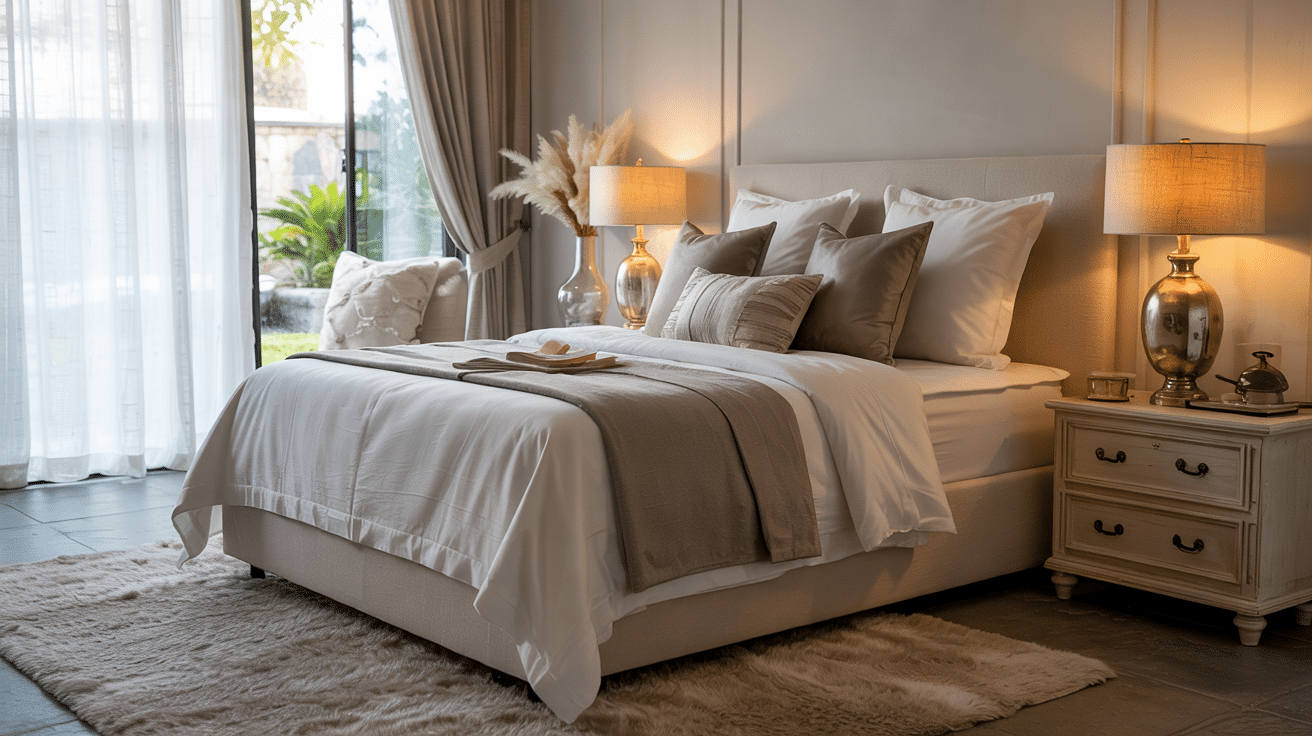Have you ever bought a new pillowcase only to find it doesn’t fit your pillow? The wrong size can turn a good night’s sleep into hours of discomfort.
Most people are unaware that there are set pillow sizes. This ignorance leads to poor sleep and wasted money on ill-fitting bedding.
The good news? You can fix this with some basic facts about standard pillow sizes.
In this guide, we’ll show you the correct sizes for every type of pillow. You’ll also learn which size best suits your sleeping style and how to pick the right pillowcases.
By the end of this post, you’ll know exactly what size pillows to buy for a perfect fit and better sleep. Let’s help you rest well tonight.
Understanding Pillow Sizes
Picking the right pillow size is not just about looks. It plays a key role in how well you sleep each night. The wrong size can cause neck pain and poor sleep quality.
Your pillow needs to keep your head in line with your spine. Too big, and your neck bends upward. Too small, and it drops down. Both can lead to morning stiffness and headaches.
The size of your pillow also affects how long you stay in one spot while sleeping. A good fit helps you move less and sleep deeper.
Different sleep styles require different pillow sizes. Side sleepers often need bigger pillows, while back and stomach sleepers do better with thinner ones.
Your bed size should match your pillow size, too. A king bed looks odd with small pillows, and a twin bed gets crowded with oversized ones.
The right size helps your pillow do its job – to keep your body in a good sleeping pose all night long.
What is the Standard Pillow Size?
The standard pillow size is 20 inches by 26 inches, and it’s the most common one found in stores across the country.
Standard pillows fit well with most bed types. They work perfectly for:
- Twin beds (where you can fit one)
- Full beds (where two sit side by side)
- Queen beds (where two fit comfortably)
The standard size provides just the right amount of support for kids and adults who don’t move much during sleep. It balances good neck support with a size that doesn’t crowd the bed.
Standard pillows also fit well into most suitcases, making them good for travel if you need to bring your pillow.
Types of Standard Pillows
Standard pillows come in two main sizes. Knowing the differences helps you pick the right one for your needs.
| Pillow Type | Width (inches) | Length (inches) | Best For | Pillowcase Fit |
|---|---|---|---|---|
| Classic Standard | 20 | 26 | Twin, Full beds, Children, Single sleepers | Standard cases |
| Super Standard | 20 | 28 | Full, Queen beds, Active sleepers, Broader shoulders | Standard cases (may be slightly loose) |
Should You Mix and Match Pillow Sizes?

Mixing pillow sizes on your bed creates a stylish, well-planned look. It adds both visual appeal and comfort to your bedroom.
Many home designers use this trick to make beds look more inviting. You can try these combos:
- Place larger pillows at the back and smaller ones in front
- Use standard pillows for sleeping and larger ones for sitting up
- Add small square pillows in front for a pop of color
For a queen bed, try this setup:
- Two standard pillows (20″ x 26″) in the back
- Two super standards (20″ x 28″) in the middle
- One or two small square pillows in front
For a king bed:
- Two king pillows (20″ x 36″) at the back
- Two standards in the middle
- Small decorative pillows in front
This layered method makes your bed look fuller and more cozy. It also gives you options for different support when reading or watching TV in bed.
Just be sure not to use too many pillows. Three to five total is usually enough for both style and function. Too many can make your bed look messy and give you nowhere to sleep!
What is the Standard Pillow Case Size?
The standard pillowcase typically measures 20″ x 30″. This size is four inches longer than a classic standard pillow (20″ x 26″), providing extra room to encase the pillow fully.
Standard pillowcases work for both classic standard pillows and super standard pillows. The extra length:
- Prevents the pillow from slipping out
- Makes insertion easier
- Allows for shrinkage after washing
The snugness of the fit affects how your pillow feels and looks. Too loose, and it seems saggy; too tight, and it compresses the filling.
How to Choose the Right Pillow Case for Standard Pillows?

When buying pillowcases, consider both fit and fabric. Cotton pillowcases offer:
- Good breathability
- Easy care
- Increasing softness with washing
Thread count matters less than fabric quality. A 300-thread-count pillowcase made from high-quality cotton often feels better than a 600-thread-count pillowcase made from lower-quality fibers. Silk pillowcases:
- Reduce hair friction
- Help keep skin smooth
- Stay cool through the night
Linen pillowcases provide excellent cooling. They cost more but last for years, becoming softer with each wash. For allergy sufferers, hypoallergenic pillowcases with tight weaves help block dust mites from reaching the pillow.
What is a Gusset and How Does it Affect Pillow Size?

A gusset is a strip of fabric that runs along the sides of a pillow, joining the top and bottom panels. This extra panel adds depth to the pillow, making it thicker than flat pillows. The gusset creates a 3D box-like shape rather than the typical flat edges seen on traditional pillows.
Key features of gusseted pillows include:
- They maintain full height to the edges
- They hold more filling than flat pillows
- They typically cost a bit more
Gussets typically range from 1 to 3 inches in width. The width of the gusset directly impacts how firm and supportive the pillow feels. Wider gussets create more space for filling, resulting in a loftier pillow that works well for side sleepers who need extra neck support. Narrower gussets produce a more moderate loft, which back and stomach sleepers often prefer.
For those who find standard pillows too flat but don’t want to move up to a larger size, a gusseted standard pillow offers a smart middle ground. You get the extra support and comfort without taking up more space on your bed.
Conclusion
Finding the right pillow size makes a big difference in your sleep quality. Standard pillows (20″ x 26″) work well for most people and beds, while super standards offer that extra bit of room.
Remember that your sleeping position matters too. Side sleepers might need fuller pillows, while back and stomach sleepers often prefer thinner ones.
Remember the cases! A good pillowcase should be slightly larger than your pillow, with enough room for easy insertion but not so loose that it looks sloppy.
Mix different sizes for your bed’s style and function. Try what feels best for you—there’s no single right answer for everyone.
The perfect pillow size gives you the best night’s sleep. Your comfort matters most, so pick what works for your body and your bed.



